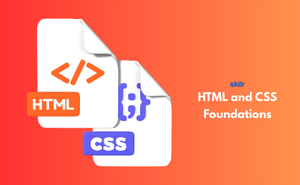👇 CELEBRATE CLOUD SECURITY DAY 👇
00
HOURS
00
MINUTES
00
SECONDS

The HTML and CSS Foundations exam provide participants with essential knowledge and practical skills in web development using HTML (Hypertext Markup Language) and CSS (Cascading Style Sheets). This exam serves as the foundation for creating visually appealing and functional websites by mastering the fundamental markup and styling languages of the web. Participants will learn how to structure web documents using HTML to define content elements, such as headings, paragraphs, lists, and links, and apply styles to these elements using CSS to achieve layout, typography, color, and other visual effects. Through hands-on exercises, real-world examples, and practical projects, participants will gain proficiency in HTML and CSS, empowering them to create responsive and well-designed web pages.
The HTML and CSS exam covers the following topics :-
Industry-endorsed certificates to strengthen your career profile.
Start learning immediately with digital materials, no delays.
Practice until you’re fully confident, at no additional charge.
Study anytime, anywhere, on laptop, tablet, or smartphone.
Courses and practice exams developed by qualified professionals.
Support available round the clock whenever you need help.
Easy-to-follow content with practice exams and assessments.
Join a global community of professionals advancing their skills.
To excel in HTML and CSS, you should understand core concepts like semantic HTML structure, form handling, tables, and attributes. In CSS, you need to master selectors, box model, positioning, flexbox, grid layouts, and responsive design techniques. Familiarity with tools like Visual Studio Code, browser developer tools, and CSS preprocessors (like SASS) can also enhance efficiency.
Industries such as IT, eCommerce, digital marketing, media, online education, and startups require web development skills. Companies need professionals to design and maintain websites, landing pages, email templates, and interactive digital experiences.
While HTML and CSS are the building blocks of web development, most employers seek additional skills like JavaScript for interactivity, responsive design techniques, and familiarity with frameworks like Bootstrap or Tailwind CSS. Knowledge of CMS platforms like WordPress and basic SEO principles can also increase employability.
HTML and CSS allow freelancers to create portfolio websites, landing pages, and custom designs for clients. Entrepreneurs can build and maintain business websites without hiring a developer. Knowledge of these languages also helps in customizing website templates for platforms like WordPress, Shopify, and Webflow.
Entry-level front-end developers with HTML and CSS skills can earn around $50,000 to $70,000 per year, depending on location and expertise. Freelancers can charge $25–$100 per hour based on project complexity. Advanced developers with JavaScript, React, or backend knowledge can earn significantly more.
UI/UX designers with HTML and CSS skills can create interactive prototypes, improve user experience, and communicate design ideas more effectively with developers. Understanding CSS helps in styling interfaces, while HTML knowledge allows designers to structure web content efficiently.
Modern trends include responsive design with CSS Grid and Flexbox, dark mode styling, animation effects using CSS, accessibility best practices, and performance optimization techniques like lazy loading images. Keeping up with these trends enhances job prospects.
Building personal projects like portfolios, blogs, and interactive web pages is crucial. Contributing to open-source projects, participating in coding challenges, and showcasing work on GitHub, CodePen, or personal websites can enhance job prospects and attract freelance clients.
Beginners can grasp the basics within a few weeks, but achieving proficiency requires practice. With consistent learning and project-based experience, most individuals become job-ready within 3–6 months.
Proficiency in HTML and CSS is essential for roles such as Front-End Developer, UI/UX Designer, Web Designer, Email Developer, and WordPress Developer. Even full-stack and backend developers benefit from basic HTML and CSS knowledge to build user-friendly interfaces.